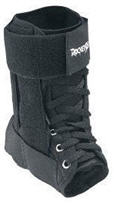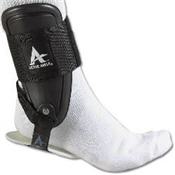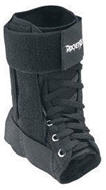The Pros and Cons of Volleyball Ankle Supports
Read facts about volleyball ankle supports. Why volleyball players should or should not use ankle support? What volleyball players should take into account when choosing the volleyball ankle brace?
Facts about Volleyball Ankle Supports
There are very few setbacks more annoying than an injury. And if wearing an ankle support offers preventative benefits against injury and recovery benefits after an injury, then why do so many volleyball players do without it?
The main reason might simply lie in the lack of knowledge about this topic. A study in the Journal of Athletic Training in 2002 revealed very little negative performance effects of ankle bracing and found that the range of motion during static measurements limited the kinds of motions typically associated with ankle injuries.
Dangerous ankle motions such as plantar flexion were reduced by 9.7 degrees of motion and inversion by 14.9 degrees of motion¹, a viable difference considering most significant ankle injuries result in one of the two.
Yet interestingly enough, the study goes on to show that the same athletes who had a slightly limited range of motion in their ankle had no significant differences in key performance activities such as sprinting and jumping. The results between a control group and a group wearing ankle support indicated no substantial performance setbacks, a compelling reason to use one for volleyball training.
So if there are very few downsides to using an ankle support, what are the positive aspects of integrating one into your training?
Benefits of Using Volleyball Ankle Supports
The two most profound benefits that come to mind are:-
Volleyball Injury Prevention
-
Volleyball Injury Recovery
The added stability and reduced harmful motion of an ankle support
provides the additional benefit of recovering from an injury after the
fact.
As discussed in the study published in 2002, there is a substantial amount of evidence from various sources to indicate that ankle supports significantly decrease dangerous ankle motions from occurring. This can help prevent an injury before it happens.

"Example of the Mechanical Model"
"Mechanical model" is commonly used ankle support for volleyball injury prevention.
Mechanical models are very durable and allow secure mobility for the ankle.
To read more about braces for the injury prevention, please go to the volleyball ankle braces page.
Reduced plantar flexion and inversion means less of the same motions that probably injured the ankle in the first place. (Ankle support prevents "ankle sprain" by limiting the dangerous ankle motions.) This inevitably leads to a faster recovery by adding stability to the weakened joint during training.
So if you’ve recently suffered an injury, it would be a good idea to equip yourself with an ankle support as you transition back into the game. A volleyball ankle support can be the key to recovering and getting back into the game more quickly.

Example of the "Sock Model"
"Sock model" is commonly used for the injury recovery.
It is a good choice for the athlete who needs extra support for the injured loose ankle.
To read more about braces for the injury recovery, please go to the volleyball ankle braces page.
Possible Negative Aspects of Volleyball Ankle
Supports - Feeling of "Weak Ankles"
However, some users of ankle supports report
mildly unpleasant side
effects when transitioning back to playing without an ankle support.
The athletes occasionally report that using an ankle support during training made their ankle feel "weaker" after they’ve removed it.
After athletes move the ankle support, some athletes experience ankle sprains, since there is less support on the ankle. While there isn’t any thorough evidence of this occurring repeatedly, it is probably the result of the athlete adapting to an increase in flexibility and a decrease in support associated with the removal of an ankle support.
If you know you eventually want to play without ankle support but are using it to recover from an injury, be prepared for this transition, since it may be a slight setback to your training.
In our opinion, those "weak ankles" issues are minor issues compared to benefits that ankle braces offer.
How to Avoid "Weak Ankles" Issues when Using Volleyball Ankle Supports?
An athlete can avoid those "weak ankles" issues by training without an ankle brace also. For example jump training and conditioning could be done without ankle braces since most injuries for volleyball players happen during the match or practice when jumping and landing by the net.¹Cordova M. L. Ingersoll C. D. Palmieri R. M. Efficacy of Prophylactic Ankle Support: An Experimental Perspective Journal of Athletic Training 37 (2002): 446-57
Volleyball Ankle Supports Related Pages
Volleyball Ankle BracesWhat kind of volleyball ankle braces we should use? And when should we wear them?
Like this page:




